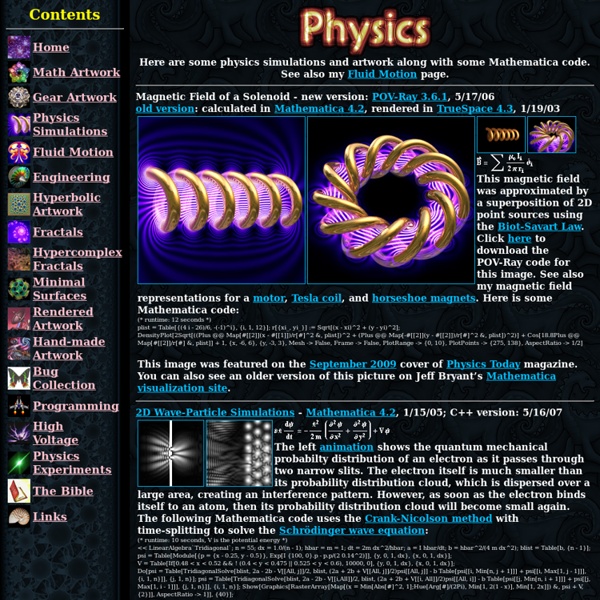Physics Simulations and Artwork
Here is a 3D view of a hydrogren atom in the 4f state. The left image was made in C++ using a technique described by Krzysztof Marczak to make it volumetric like a cloud of smoke. The right image was made in Mathematica by adding 2D cross-sectional layers. The animations were made in POV-Ray using DF3 density files. The right animation shows what a "12o" orbital might look like. POV-Ray has a built-in internal function for the 3d orbital: // runtime: 4 seconds camera{location 16*z look_at 0} #declare P=function{internal(53)}; #declare P0=P(0,3,0,0); box{-8,8 pigment{rgbt t} hollow interior{media{emission 0.5 density{function{(P(x,y,z,0)-1.2)/(P0-1.2)} color_map{[0 rgb 0][1 rgb 1]}}}}} Links Atomic Orbital - time-dependant hydrogen atom simulation, by ?
http://www.bugman123.com/Physics/index.html
Math, Physics, and Engineering Applets
Oscillations and Waves Acoustics Signal Processing
Usenet Physics FAQ
Version Date: February 2018 This list of answers to frequently asked questions in physics was created by Scott Chase in 1992. Its purpose was to provide good answers to questions that had been discussed often in the sci.physics and related Internet news groups. The articles in this FAQ are based on those discussions and on information from good reference sources.
NetLogo Home Page
NetLogo is a multi-agent programmable modeling environment. It is used by many hundreds of thousands of students, teachers, and researchers worldwide. It also powers HubNet participatory simulations. It is authored by Uri Wilensky and developed at the CCL. You can download it free of charge. You can also try it online through NetLogo Web.
Gerard ’t Hooft, Theoretical Physics as a Challenge
by Gerard 't Hooft Note: This web site will soon be removed from its present address. An updated and renewed version is available at: This is a web site for young students - and anyone else - who are (like me) thrilled by the challenges posed by real science, and who are - like me - determined to use their brains to discover new things about the physical world that we are living in. In short, it is for all those who decided to study theoretical physics, in their own time.
Modellus - Inicio
Modellus es una aplicación disponible de manera gratuita de cara a permitir que tanto alumnos como profesores ( de instituto y de universidad) puedan utilizar la matemática para crear o explotar modelos de una manera muy interactiva y sencilla. El Modellus se utiliza para hacer una modelización en el ordenador, de cara a permitir una creación sencilla y muy intuitiva de modelos matemáticos solamente con recurso a una notación matemática estándar , por permitir la creación de animaciones con objetos interactivos que con propiedades matemáticas expresadas en el modelo, de cara a permitir la explotación de múltiples representaciones pero también permitir el análisis de datos experimentales con la forma de imágenes, animaciones, gráficos e tablas. El principal objetivo de Modellus és la modelación y el significado de los modelos.
Mozilla Firefox (Build 20120905151427)
CircuitLab - online schematic editor & circuit simulator
Related:



